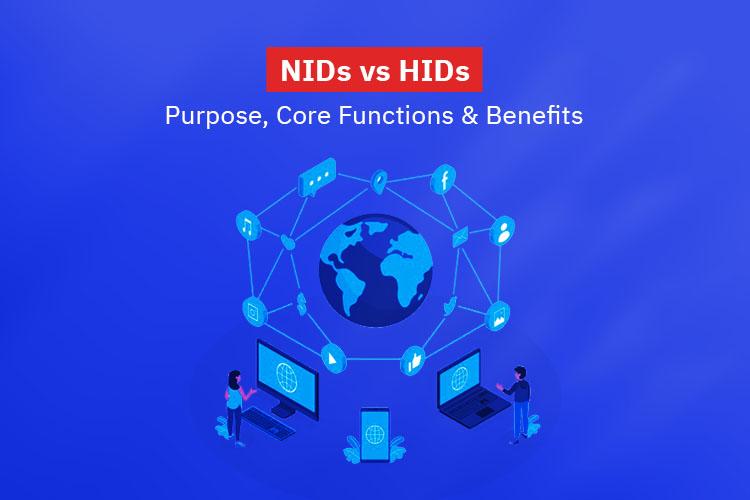With the increased ratio of attacks, the network intrusion detection systems are essential for securing your networks. The most dangerous hacker is the one who hides his activity and gets your confidential data again and again. So, there are many methods used to protect the system or network. In this article, you will learn about the best IDSs, comprehensive overview of NIDs vs HIDs.
NIDs
Network-based Intrusion Detection System is also known as network IDS or NIDS used to examine the network traffic. A network intrusion system has to include a packet sniffer to gather network traffic for further analysis.
You can easily add your own rules and modify the analysis engine of a NIDS. So, if you have multiple NIDS, the system provider or community will provide the rules to understand the syntax or implementation.
If you are thinking of collecting all of the data for analyzing, it is difficult, and you don’t want to dump all traffic into files. So, with the help of NIDS, you can easily capture only the selective data. If you have made a rule for a type of worrisome HTTP traffic, the network intrusion detection system only captures and store HTTP packets that display those particular characteristics.
When looking at NIDs vs HIDs, keep in mind the NIDS is required to be installed on dedicated hardware, and it comes with expensive enterprise solutions. NIDS requires a sensor module for capturing network traffic, so you can also load it using a LAN analyzer or dedicated a computer to execute this task. But, choose a computer with a higher clock speed not to slow down the network.
HIDs
Host-based intrusion detection systems (HIDS) are also known as host-based IDS or host intrusion detection systems and used to analyze events on a computing device rather than the data traffic that passes around the computer. HIDS mainly operates by taking and looking at data in admin files (log files and config files) on the computing device that it protects.
Host intrusion detection system will back up your config files so that you can restore your settings in case of any malicious attack. Moreover, it is also mandatory to protect your root access on Unix-like platforms and registry modification on Windows-based systems. So, HIDS is unable to block those modifications, but it ought to have the ability to alert you if any such access happens.
All hosts connected to your network under the HIDS monitoring have the required software installed on it. If you want to get feedback from more than one device connected to your network, there is no need to sign-in on each device. Remember, a distributed HIDS system requires a centralized control module. So, it is recommended to use a system that encrypts the communication between the central monitor and host agents.
NIDs vs HIDs: Purpose

When the network attacks are getting increased day by day, both HIDS and NIDS have become popular. But if you want to protect your personal or individual computers, then there is no need to use NIDS and HIDS because you can use anti-malware suits and firewalls. There are many network security tools that are used to protect your networks and computing devices. While understanding NIDs vs HIDs, it is a common question “when we have firewalls and other anti-malware solutions then why we need both HIDS and NIDS?” Let me explain, these tools can protect your personal computer, but they lack the intelligence to defend any corporate network. Both HIDS and NIDS capture the network traffic and compare the collected information with predefined patterns to discover the attacks and vulnerabilities.
NIDs vs HIDs: Core Functions
Host-based Intrusion Detection systems examine particular host-based activities, for example, what software has been used, what documents have been accessed, and what information resides in the kernel logs. At the same time, the Network Intrusion Detection systems examine the flow of data between computers (network traffic). Therefore, NIDs can discover a hacker until he can generate an unauthorized attack, whereas HIDs will not understand anything is wrong until the hacker has breached the machine. Both are necessary for sniffing the network for suspicious activities.
NIDs vs HIDs: Benefits
NIDs Benefits
Where NIDs excel and have the capacity to safeguard countless computing devices from a network location. This is the best option, which is simpler to deploy and less costly. NIDs also supply a wider evaluation of a big and corporate network through scans and probes. Moreover, administrators are able to protect other devices such as print servers, firewalls, routers and VPN concentrators. NIDs are flexible with several operating systems and devices and protect the network from bandwidth floods as well as DoS attacks.
HIDs Benefits
Although HIDs might appear to be a lousy solution, initially they have many advantages. For starters, they could prevent attacks from causing any damage. As an example, if a malicious file tries to rewrite a document, the HID will cut off its rights and quarantine it. Host-based intrusion detection systems may keep laptops and personal computers protected whenever they are removed or taken off from a network and into the field. In short, the HIDs are the last line of defense used to ward off some attacks that are missed by NIDs.
Final Words
In order to protect your networks and computers, you need to understand the common causes, process, and prevention methods of a data breach. It is also recommended to realize what can someone do with your IP and how to prevent it. With the help of useful information and the implementation of both HIDs and NIDs, you can shut all the security loopholes.

